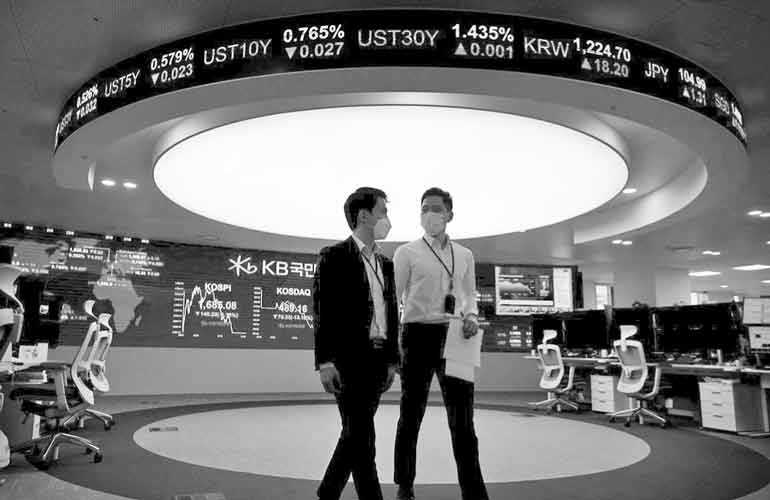Friday Apr 04, 2025
Friday Apr 04, 2025
Saturday, 14 March 2020 00:00 - - {{hitsCtrl.values.hits}}

SINGAPORE (Reuters): Global stock markets crashed on Friday, ending a years-long bull run, with coronavirus panic selling hitting almost every asset class and leaving investors nowhere to hide.
Half a trillion dollars in liquidity from the US Federal Reserve and the promise of more were not enough to calm the fear that has wiped some $14 trillion from world stocks in a month.
On Friday, Japanese stocks were in freefall and markets from Seoul to Jakarta punched through downlimit circuit breakers.
The Nikkei dropped as far as 10% and is heading for its worst week since the 2008 financial crisis. Not one stock on the index is in positive territory.
Losses were equally staggering outside Japan, driving MSCI’s broad Asia-Pacific index back to where it was in 2017. Gold and oil fell and once-safe sovereign bonds slumped as investors liquidated everything they could to cover losses.
Even after its worst crash since Black Monday in 1987 overnight, Dow futures are down about 3% in Asia, as are S&P 500 futures.
“There is a sense of fear and panic,” said James Tao, an analyst at stockbroker Commsec in Sydney, where phones at the high-value client desk rang non-stop.
“It’s one of those situations where there is so much uncertainty that no-one quite knows how to respond...if it’s fight or flight, many people are choosing flight at the moment.”
Australia’s benchmark fell as far as 8% and is set for its worst week on record. In South Korea the won was shredded and the Kospi fell 7.7%.
Hong Kong’s Hang Seng index fell 5%. China’s Shanghai composite fell 3%.
In currency markets the dollar was king and Asian currencies haemorrhaged as fears of systemic risks drove demand for the world’s reserve currency.
Majors stabilised after furious dollar buying overnight, with the euro finding footing around $1.1200 and the Aussie recovering to $0.6300.
Emerging market currencies were punished: the won and baht dropped 1% and the rupiah 2%.
The plunge, as the coronavirus pandemic spreads, gathered pace after US President Donald Trump spooked investors with a move to restrict travel from Europe, and after the European Central Bank disappointed markets by holding back on rate cuts.
In a televised address late on Wednesday, Trump imposed restrictions on travel from Europe to the United States, shocking investors and travellers.
Traders were disappointed after hoping to see broader measures to fight the spread of the virus and blunt its expected blow to economic growth.
“Government bureaucracy simply has not kept pace with the nature of the outbreak and market expectations,” said Tai Hui, Chief Asia Market Strategist, J.P. Morgan Asset Management.
“We need to see the number of new infections stabilise...we also need to see fiscal and monetary policy support implementation,” he said.
“Hence, we are not looking at a specific time or valuation to advise investors to add back equities.”
Trade was halted on the S&P 500 overnight after it hit circuit breakers. It fell further when trade resumed, eventually losing 9.5% to close 27% below February’s peak.
The VIX volatility index – Wall Street’s “fear gauge” – and an equivalent measure of volatility for the Euro Stoxx 50 hit their highest since the 2008 financial crisis.
Gold, usually a safe harbour in times of panic, has fallen 4% to $1,563.42 an ounce in two days. Bond yields, which rise when prices fall, lifted on long-dated US Treasuries overnight and held there on Friday.
Sovereign 10-year yields for Australia, Japan, New Zealand, Thailand, Korea and Singapore rose.
“Wherever anyone has any risk, people just want to bring risk back to flat at the moment, that’s what happening,” said Stuart Oakley, Nomura’s global head of flow FX in Singapore
“This is what happens when you get what’s known as a value-at-risk shock, where people have drawn down so much P&L that they just need to draw down all risk.”
To try and head off the sort of dislocation that saw markets seize up during the financial crisis more than a decade ago, the New York Federal Reserve surprised by pumping huge amounts of cash into the banking system.
After adding $500 billion on Thursday, it will inject another $1 trillion on Friday in an effort to stop borrowing costs from rising. Australia’s central bank injected an unusually large $5.5 billion into the financial system.
In commodities, Brent crude is set for its biggest weekly drop since 1991 and was going backwards on Friday.
Brent was down 50 cents, or 1.5%, at $32.74 a barrel after falling more than 7% on Thursday. US crude was down 1.6% at $30.99 per barrel.
Discover Kapruka, the leading online shopping platform in Sri Lanka, where you can conveniently send Gifts and Flowers to your loved ones for any event including Valentine ’s Day. Explore a wide range of popular Shopping Categories on Kapruka, including Toys, Groceries, Electronics, Birthday Cakes, Fruits, Chocolates, Flower Bouquets, Clothing, Watches, Lingerie, Gift Sets and Jewellery. Also if you’re interested in selling with Kapruka, Partner Central by Kapruka is the best solution to start with. Moreover, through Kapruka Global Shop, you can also enjoy the convenience of purchasing products from renowned platforms like Amazon and eBay and have them delivered to Sri Lanka.
Discover Kapruka, the leading online shopping platform in Sri Lanka, where you can conveniently send Gifts and Flowers to your loved ones for any event including Valentine ’s Day. Explore a wide range of popular Shopping Categories on Kapruka, including Toys, Groceries, Electronics, Birthday Cakes, Fruits, Chocolates, Flower Bouquets, Clothing, Watches, Lingerie, Gift Sets and Jewellery. Also if you’re interested in selling with Kapruka, Partner Central by Kapruka is the best solution to start with. Moreover, through Kapruka Global Shop, you can also enjoy the convenience of purchasing products from renowned platforms like Amazon and eBay and have them delivered to Sri Lanka.